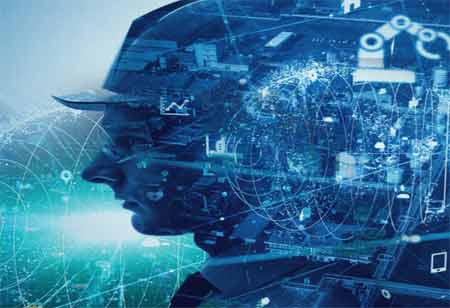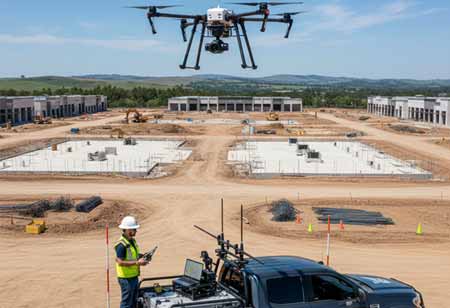THANK YOU FOR SUBSCRIBING
Be first to read the latest tech news, Industry Leader's Insights, and CIO interviews of medium and large enterprises exclusively from Applied Technology Review
AI in Railways: Predictive Analytics & Maintenance
The railway sector is undergoing a transformation through the integration of AI-driven predictive analytics and maintenance systems.

By
Applied Technology Review | Tuesday, October 03, 2023
Stay ahead of the industry with exclusive feature stories on the top companies, expert insights and the latest news delivered straight to your inbox. Subscribe today.
Continued investment in AI-driven solutions holds the potential to revolutionise the railway sector, ushering in an era of smarter, more sustainable, and highly efficient transportation networks.
FREMONT, CA: The railway sector is undergoing a transformation through the integration of AI-driven predictive analytics and maintenance systems. This cutting-edge technology is reshaping how rail networks are operated and infrastructures maintained. By harnessing the power of artificial intelligence, railway operators proactively predict and prevent equipment failures, optimise scheduling, and enhance safety. These advancements minimise downtime and maintenance costs and significantly improve rail services' overall efficiency and reliability. As a result, the integration of AI is poised to transform the industry, ensuring smoother, more reliable, and cost-effective transportation for passengers and cargo alike. Predictive maintenance here employs AI-driven analytics to avert train accidents in the railroad industry. A comprehensive examination of predictive maintenance's diverse applications within this sector reveals its significance.
Wheel and Track Condition Monitoring
AI assumes a crucial role in transforming the monitoring of wheel and track conditions, delivering exceptional advantages to the railroad industry. The capability to track the health of wheels and tracks in real-time empowers operators by providing timely insights into the state of vital components. Leveraging advanced AI algorithms, it becomes possible to rapidly recognise patterns of wear and tear, allowing for proactive maintenance. The utilisation of real-time data for predictive maintenance enables the accurate anticipation of maintenance intervals, thereby averting potential derailments and ensuring trains' safe and dependable operations.
These state-of-the-art AI solutions in the railway sector lay the groundwork for sophisticated AI-based train control systems. By continuously overseeing the conditions of wheels and tracks, the control system optimises train speed and makes instantaneous adjustments, thus bolstering safety and efficiency across railway networks.
Fault Detection in Rolling Stock
The utilisation of machine learning in the railway industry significantly enhances the detection of faults in rolling stock, offering substantial advantages to the sector. Potential equipment issues are promptly identified through the continuous monitoring of locomotives and carriages. AI-driven algorithms play a pivotal role in enabling the early detection of problems and facilitating proactive measures to prevent them from developing into expensive breakdowns. The approach, which addresses issues at their inception, allows maintenance teams to reduce downtime and avoid costly repairs, ensuring the seamless operation of trains. As predictive maintenance in rolling stock becomes more advanced, intelligent railways with AI are becoming a reality, resulting in a safer, more dependable, and cost-efficient railway system that sets new industry standards.
Predicting Component Failures
The introduction of AI applications within the railway sector has ushered in a transformative capacity for predicting component failures, fundamentally reshaping maintenance practices in the industry. AI-driven sensors continuously monitor critical elements such as breaks and bearings. These sensors continually assess real-time data; they can detect subtle irregularities that serve as early indicators of potential failures. By foreseeing potential issues, maintenance teams proactively implement timely inspections and preventive maintenance procedures.
Optimising Maintenance Scheduling
Using AI-driven solutions in the railway sector offers a transformative advantage, as it enhances maintenance scheduling. Dynamic scheduling fueled by real-time data ensures efficient allocation of resources and service disruptions are minimised. With AI-powered algorithms, railway operations anticipate suitable times or conduct maintenance activities, optimising the utilisation of available resources.
Adopting predictive maintenance enables operators to proactively address maintenance requirements, reducing the likelihood of unexpected breakdowns and minimising delays. This data-centric approach establishes a new benchmark for efficient and dependable railway operations, fundamentally transforming the management of maintenance tasks.
Weather-Induced Maintenance Alerts
Harnessing the capabilities of artificial intelligence in the railway sector, predictive maintenance transcends conventional approaches by providing alerts related to weather-induced maintenance that deliver substantial advantages to the railroad industry. Railway operations can forecast weather-related wear and tear on their tasks and infrastructure by integrating weather forecasts into maintenance systems. Through weather-induced maintenance alerts, railway systems proactively tackle weather-related challenges, ensuring their trains' continuous and secure operation.
Energy Consumption Optimisation
The integration of machine learning into the railroad industry has brought significant benefits to energy consumption optimisation. By analysing the energy usage patterns of trains, opportunities for enhanced energy efficiency are identified. The implementation of autonomous trains and artificial intelligence has enabled the dynamic adjustment of speed and power consumption in response to real-time data, resulting in reduced operational costs.
Autonomous trains equipped with AI systems have the capability to adapt their speed and power consumption on the fly, using real-time data to optimise energy usage without compromising safety or travel time. This transformation has reduced operational expenses and minimised the environmental impact of railway operations. With the adoption of machine learning-driven predictive analytics and autonomous technologies, the railway industry has evolved into a more environmentally friendly and economically sustainable mode of transportation.
Predictive Signal and Communication Systems
The utilisation of AI-driven signalling and communication systems represents a significant transformation within the railroad sector, ushering in a new era of enhanced safety and reliability for train operations. These advanced systems have the capacity to predict signal and communication failures, thus guaranteeing the continuous and secure operation of trains.
AI algorithms possess the ability to scrutinise real-time data from communication networks and signalling equipment, identifying irregularities or discerning patterns that signify potential failures. This early detection allows maintenance teams to receive advanced alerts, promptly addressing and resolving these issues, thereby preventing disruptions and ensuring the smooth running of train services.
Preventing Catenary and Power Failures
The adoption of AI in the railway industry represents a transformative approach to preventing catenary and powerful failures, thus ensuring seamless train services. AI-driven solutions are utilised to monitor overhead power lines and electrification systems, proactively identifying and resolving potential problems. AI algorithms are continuously employed to analyse data related to the power infrastructure, aiming to detect irregularities like voltage fluctuations or signs of wear on overhead wires. They are detecting such issues early on power maintenance teams to take prompt action, thereby presenting power failures and service disruptions.
Track and Infrastructure Maintenance
Using AI in the railway sector presents a groundbreaking approach to the upkeep of racks and infrastructure, offering several advantages to the industry. By incorporating AI solutions, railway operators proactively oversee crucial elements such as overhead power lines and electrification systems.
Implementing AI-driven predictive analytics enables the early detection of potential problems that could disrupt train services. For instance, deviations in voltage levels or indications of wear and tear on overhead wires are promptly identified in real time. Maintenance teams can immediately prevent power outages, ensuring a continuous power supply for trains.
Predictive Fleet Management
When the railway industry embraces AI for predictive maintenance, it ushers in a transformative concept for managing its fleet. Through AI-driven analytics to examine the performance data of the entire train fleet, operators are equipped with invaluable insights into the condition of each train.
AI-driven algorithms provide forecasts for the maintenance requirements of each train, enabling maintenance teams to plan and execute timely interventions. For example, predictive analytics anticipate the remaining useful life of critical components like engines and brakes, allowing for proactive replacements before any failures occur.
Realise the Potential of AI-Powered Predictive Analytics
In the rapidly evolving railway sector, leveraging the capabilities of a generative AI development company is essential for unlocking the full potential of predictive analytics. With extensive proficiency in crafting AI-driven predictive analytics applications, it empowers railway operators to base their decisions on data-driven insights. Through the application of AI algorithms, they efficiently optimise maintenance schedules and foresee potential issues in crucial components such as tracks, signalling systems, and rolling stock.
Integrating AI-powered predictive analytics and maintenance into the railway industry marks a significant leap forward in efficiency, safety, and cost-effectiveness. By harnessing the capabilities of artificial intelligence, railways proactively identify and address maintenance needs, preventing costly breakdowns and enhancing overall operational reliability. This transformative technology extends the lifespan of railway infrastructure and improves passenger safety and satisfaction.
I agree We use cookies on this website to enhance your user experience. By clicking any link on this page you are giving your consent for us to set cookies. More info








